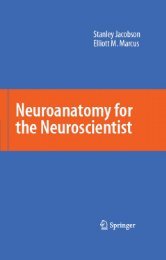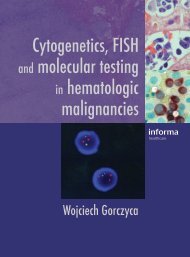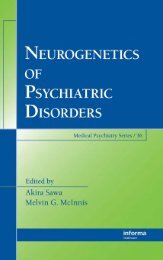Color Atlas of Hematology - Practical Microscopic and Clinical ...
Color Atlas of Hematology - Practical Microscopic and Clinical ...
Color Atlas of Hematology - Practical Microscopic and Clinical ...
- No tags were found...
You also want an ePaper? Increase the reach of your titles
YUMPU automatically turns print PDFs into web optimized ePapers that Google loves.
124Abnormalities <strong>of</strong> the White Cell SeriesElevated Eosinophil <strong>and</strong> Basophil CountsIn accordance with their physiological role, an increase in eosinophils( 400/µl, i.e. for a leukocyte count <strong>of</strong> 6000, more than 8% in the differentialblood analysis) is usually due to parasitic attack (p. 5). In the Westernhemisphere, parasitic infestations are investigated on the basis <strong>of</strong> stoolsamples <strong>and</strong> serology.Strongyloides stercoralis in particular causes strong, sometimes extreme,elevation <strong>of</strong> eosinophils (may be up to 50%). However, eosinophilia <strong>of</strong>variable degree is also seen in ameba infection, in lambliasis (giardiasis),schistosomiasis, filariasis, <strong>and</strong> even malaria.Bacterial <strong>and</strong> viral infections are both unlikely ever to lead to eosinophiliaexcept in a few patients with scarlet fever, mononucleosis, or infectiouslymphocytosis. The second most common group <strong>of</strong> causes <strong>of</strong> eosinophiliaare allergic conditions: these include asthma, hay fever, <strong>and</strong> various dermatoses(urticaria, psoriasis). This second group also includes druginducedhypersensitivity with its almost infinitely multifarious triggers,among which various antibiotics, gold preparations, hydantoin derivatives,phenothiazines, <strong>and</strong> dextrans appear to be the most prevalent.Eosinophilia is also seen in autoimmune diseases, especially inscleroderma <strong>and</strong> panarteritis. All neoplasias can lead to “paraneoplastic”eosinophilia, <strong>and</strong> in Hodgkin’s disease it appears to play a special role inthe pathology, although it is nevertheless not always present.A specific hypereosinophilia syndrome with extreme values (usually 40%) is seen clinically in association with various combinations <strong>of</strong>splenomegaly, heart defects, <strong>and</strong> pulmonary infiltration (Loeffler syndrome),<strong>and</strong> is classified somewhere between autoimmune diseases <strong>and</strong>myeloproliferative syndromes. Of the leukemias, CML usually manifestsmoderate eosinophilia in addition to its other typical criteria (see p. 114).When moderate eosinophilia dominates the hematological picture, theterm chronic eosinophilic leukemia is used. Acute, absolute predominance<strong>of</strong> eosinophil blasts with concomitant decrease in neutrophils, erythrocytes,<strong>and</strong> thrombocytes suggests the possibility <strong>of</strong> the very rare acuteeosinophilic leukemia.Elevated Basophil Counts. Elevation <strong>of</strong> segmented basophils to more than2–3% or 150/µl is rare <strong>and</strong>, in accordance with their physiological role inthe immune system regulation, is seen inconsistently in allergic reactionsto food, drugs, or parasites (especially filariae <strong>and</strong> schistosomes), i.e., usuallyin conditions in which eosinophilia is also seen. Infectious diseasesthat may show basophilia are tuberculosis <strong>and</strong> chickenpox; metabolic diseaseswhere basophilia may occur are myxedema <strong>and</strong> hyperlipidemia. Autonomicproliferations <strong>of</strong> basophils are part <strong>of</strong> the myeloproliferative






